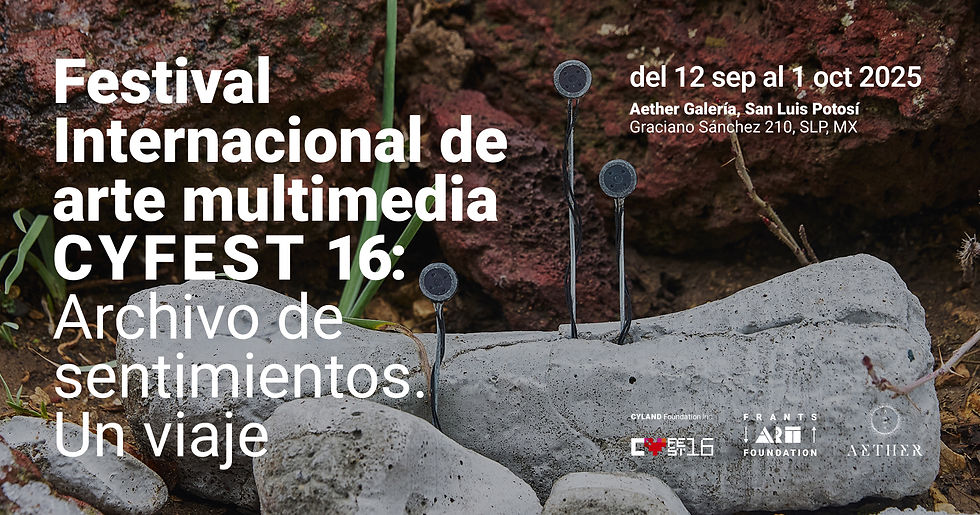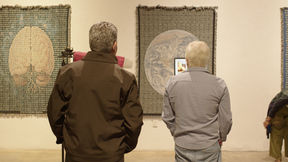International Media Art Festival
CYFEST 16: Archive of Feelings. A Journey
Festival Internacional de arte multimedia
CYFEST 16: Archivo de sentimientos. Un viaje
Organiser CYLAND Foundation Inc.
General Sponsor: Frants Foundation
Venue
Aether Contemporary Art Gallery
Graciano Sánchez 220‑A, Colonia Lindavista, San Luis Potosí, Mexico
Dates: September 12 — October 1, 2025
Hours: 09:30 am - 18:30 pm
Opening Night: Friday, September 12, 2025
Doors open: 7:30 PM
Curators
Anna Frants, Elena Gubanova, Alexandra Dementieva, Lidiia Griaznova, Sergei Komarov, Manuel Cocho Ursini
Artists
Alexandra Dementieva, Anna Frants, Alexey Grachev, Elena Gubanova & Ivan Govorkov, Sergei Komarov & Lidiia Griaznova, Anna Martynenko, Alexander Terebenin, Alexander Bochkov & Matvei Peshkov (stackedplot)
Organizador CYLAND Foundation Inc.
Patrocinador general: Frants Foundation
Lugar
Galería de Arte Contemporáneo Aether Graciano Sánchez 220-A, Colonia Lindavista, San Luis Potosí, México
Fechas: 12 de septiembre — 1 de octubre de 2025
Horario: 09:30 – 18:30
Noche de inauguración: viernes, 12 de septiembre de 2025
Apertura de puertas: 19:30
Curadores
Anna Frants, Elena Gubanova, Alexandra Dementieva, Lidiia Griaznova, Sergei Komarov, Manuel Cocho Ursini
Artistas
Alexandra Dementieva, Anna Frants, Alexey Grachev, Elena Gubanova & Ivan Govorkov, Sergei Komarov & Lidiia Griaznova, Anna Martynenko, Alexander Terebenin, Alexander Bochkov & Matvei Peshkov (stackedplot)
CYLAND MediaArtLab presents
International Media Art Festival CYFEST 16 at Aether Contemporary Art Gallery
CYLAND MediaArtLab, in collaboration with Aether Contemporary Art Gallery, is pleased to announce the 16th edition of the International Media Art Festival CYFEST: Archive of Feelings. A Journey in San Luis Potosí. As one of the longest-running international media art festivals, CYFEST brings together artists, curators, engineers, and media thinkers from around the world acting as a platform for both emerging and established creators working in interactive installations, sound, video art, XR/VR environments, algorithmic composition, and hybrid forms. CYFEST is a nomadic exhibition series—its 16th edition began in Yerevan, Armenia, continued in Mexico City, and is next opening at Aether Gallery in San Luis Potosí from September 12 to October 1.
This year’s theme, ‘Archive of Feelings. A Journey,’ explores the complex relationship between emotional life and technological environments. It considers both the personal and collective dimensions of memory, perception, and inner experience—foregrounding the contradictions between human sensitivity and the impersonal nature of digital systems. The project proposes a return to emotional awareness as a form of resistance against depersonalization, while also acknowledging that new technologies are built from and upon archives of human knowledge and feeling.
The exhibition presents a range of works—from sound installations and algorithmic video to XR environments and robotic forms—that investigate how emotions are preserved, glitched, or lost in translation through technological systems. Rather than offering a nostalgic view of the past or a utopian vision of the future, CYFEST 16 becomes a site to examine how memory is formed, recorded, and manipulated—inviting the audience to engage with technology not only as a tool, but as a mediator of the human condition.
The exhibition opens with a live audiovisual performance sessions by Sergei Komarov & Lidiia Griaznova, Alexander Bochkov & Matvei Peshkov (stackedplot), Alexey Grachev.
CYLAND MediaArtLab presenta
Festival Internacional de Arte Multimedia CYFEST 16 en Aether, Galería de Arte Contemporáneo
CYLAND MediaArtLab, en colaboración con Aether, Galería de Arte Contemporáneo, se complace en anunciar la 16.a edición del Festival Internacional de Arte Multimedia CYFEST: Archivo de sentimientos. Un viaje en San Luis Potosí. Como uno de los festivales internacionales de arte multimedia más antiguos, CYFEST reúne a artistas, curadores, ingenieros e intelectuales de todo el mundo y funciona como una plataforma tanto para creadores emergentes como para creadores consolidados que trabajan en instalaciones interactivas, sonido, videoarte, entornos de realidad extendida (XR) y/o de realidad virtual (VR), composición algorítmica y formas híbridas. CYFEST es una serie de exposiciones nómadas—su 16.a edición empezó en Ereván, Armenia; continuó en la Ciudad de México y próximamente se inaugurará en la galería Aether en San Luis Potosí del 12 de septiembre al 1 de octubre.
El tema de este año, “Archivo de sentimientos. Un viaje”, explora la compleja relación entre la vida emocional y los entornos tecnológicos y tiene en cuenta tanto las dimensiones personales como las colectivas de la memoria, la percepción y la experiencia interior—resaltando las contradicciones entre la sensibilidad humana y la naturaleza impersonal de los sistemas digitales. Este proyecto propone un regreso a la conciencia emocional como una forma de resistencia contra la despersonalización, aunque también reconoce que las nuevas tecnologías se han creado a partir de y en los archivos del conocimiento y sentimientos humanos.
La exposición presenta una variedad de obras—desde instalaciones sonoras y video algorítmico hasta entornos de realidad extendida (XR) y formas robóticas—que investigan cómo las emociones se conservan, se alteran o se pierden en la traducción por los sistemas tecnológicos. En vez de ofrecer una perspectiva nostálgica del pasado o una perspectiva utópica del futuro, CYFEST 16 se convierte en el sitio donde examinar cómo se forma, graba y manipula la memoria—invitando al público a involucrarse con la tecnología no solamente como una herramienta, sino también como mediadora de la condición humana.
La exposición se inaugurará con una presentación audiovisual (Sergei Komarov & Lidiia Griaznova, Alexander Bochkov & Matvei Peshkov (stackedplot), Alexey Grachev) en vivo que activará el espacio a través del sonido, la imagen y la presencia.

Alexandra Dementieva










Planet Kquaan
Alexandra Dementieva








The Missive
Anna Frants






To Make a Long Story Short
Alexey Grachev






Sense of Proportion
Elena Gubanova & Ivan Govorkov






Wind of changes
Sergei Komarov and Lidiia Griaznova


Double Pendulum
Anna Martynenko








Mesozoic
Alexander Terebenin






Triptychs
Alexandra Dementieva










Planeta Kquaan
Alexandra Dementieva








La Misiva
Anna Frants






Para no hacer una historia larga
Alexey Grachev






Sentido de la proporción
Elena Gubanova & Ivan Govorkov






Viento de cambio
Sergei Komarov and Lidiia Griaznova


Péndulo Doble
Anna Martynenko








Mesozoico
Alexander Terebenin






Trípticos













